KIA Sportage 2005 JE_ / 2.G Manual PDF
Manufacturer: KIA, Model Year: 2005, Model line: Sportage, Model: KIA Sportage 2005 JE_ / 2.GPages: 354, PDF Size: 2.78 MB
Page 71 of 354
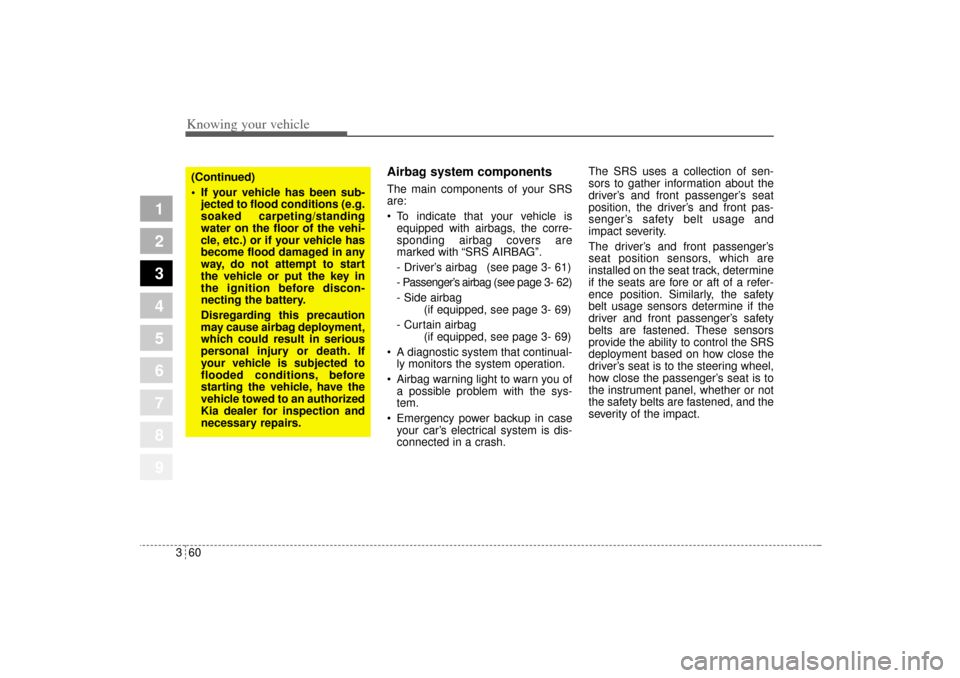
Knowing your vehicle60 3
1
2
3
4
5
6
7
8
9
Airbag system components The main components of your SRS
are:
To indicate that your vehicle is
equipped with airbags, the corre-
sponding airbag covers are
marked with “SRS AIRBAG”.
- Driver’s airbag (see page 3- 61)
- Passenger’s airbag(see page 3- 62)
- Side airbag
(if equipped, see page 3- 69)
- Curtain airbag
(if equipped, see page 3- 69)
A diagnostic system that continual-
ly monitors the system operation.
Airbag warning light to warn you of
a possible problem with the sys-
tem.
Emergency power backup in case
your car’s electrical system is dis-
connected in a crash.The SRS uses a collection of sen-
sors to gather information about the
driver’s and front passenger’s seat
position, the driver’s and front pas-
senger’s safety belt usage and
impact severity.
The driver’s and front passenger’s
seat position sensors, which are
installed on the seat track, determine
if the seats are fore or aft of a refer-
ence position. Similarly, the safety
belt usage sensors determine if the
driver and front passenger’s safety
belts are fastened. These sensors
provide the ability to control the SRS
deployment based on how close the
driver’s seat is to the steering wheel,
how close the passenger’s seat is to
the instrument panel, whether or not
the safety belts are fastened, and the
severity of the impact.
(Continued)
If your vehicle has been sub-
jected to flood conditions (e.g.
soaked carpeting/standing
water on the floor of the vehi-
cle, etc.) or if your vehicle has
become flood damaged in any
way, do not attempt to start
the vehicle or put the key in
the ignition before discon-
necting the battery.
Disregarding this precaution
may cause airbag deployment,
which could result in serious
personal injury or death. If
your vehicle is subjected to
flooded conditions, before
starting the vehicle, have the
vehicle towed to an authorized
Kia dealer for inspection and
necessary repairs.
KM CAN (ENG) 3 (~112).qxd 9/13/2004 4:50 PM Page 60
Page 72 of 354
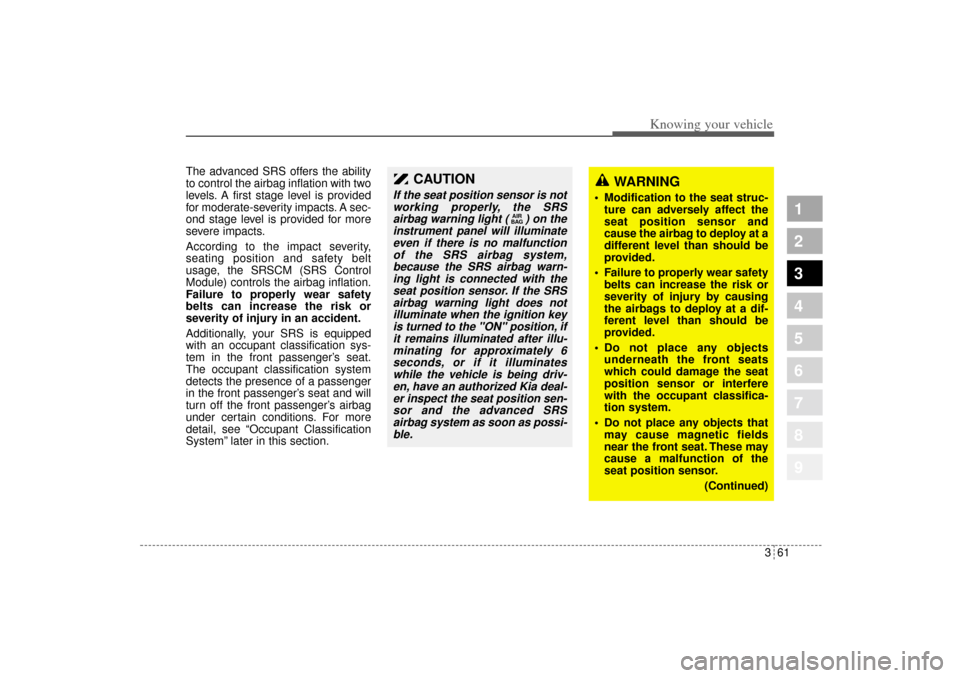
361
1
2
3
4
5
6
7
8
9
Knowing your vehicle
The advanced SRS offers the ability
to control the airbag inflation with two
levels. A first stage level is provided
for moderate-severity impacts. A sec-
ond stage level is provided for more
severe impacts.
According to the impact severity,
seating position and safety belt
usage, the SRSCM (SRS Control
Module) controls the airbag inflation.
Failure to properly wear safety
belts can increase the risk or
severity of injury in an accident.
Additionally, your SRS is equipped
with an occupant classification sys-
tem in the front passenger’s seat.
The occupant classification system
detects the presence of a passenger
in the front passenger’s seat and will
turn off the front passenger’s airbag
under certain conditions. For more
detail, see “Occupant Classification
System” later in this section.
CAUTION
If the seat position sensor is not
working properly, the SRS
airbag warning light ( ) on the
instrument panel will illuminate
even if there is no malfunction
of the SRS airbag system,
because the SRS airbag warn-
ing light is connected with the
seat position sensor. If the SRS
airbag warning light does not
illuminate when the ignition key
is turned to the "ON" position, if
it remains illuminated after illu-
minating for approximately 6
seconds, or if it illuminates
while the vehicle is being driv-
en, have an authorized Kia deal-
er inspect the seat position sen-
sor and the advanced SRS
airbag system as soon as possi-
ble.
AIR
BAG
WARNING
Modification to the seat struc-
ture can adversely affect the
seat position sensor and
cause the airbag to deploy at a
different level than should be
provided.
Failure to properly wear safety
belts can increase the risk or
severity of injury by causing
the airbags to deploy at a dif-
ferent level than should be
provided.
Do not place any objects
underneath the front seats
which could damage the seat
position sensor or interfere
with the occupant classifica-
tion system.
Do not place any objects that
may cause magnetic fields
near the front seat. These may
cause a malfunction of the
seat position sensor.
(Continued)
KM CAN (ENG) 3 (~112).qxd 9/13/2004 4:50 PM Page 61
Page 73 of 354
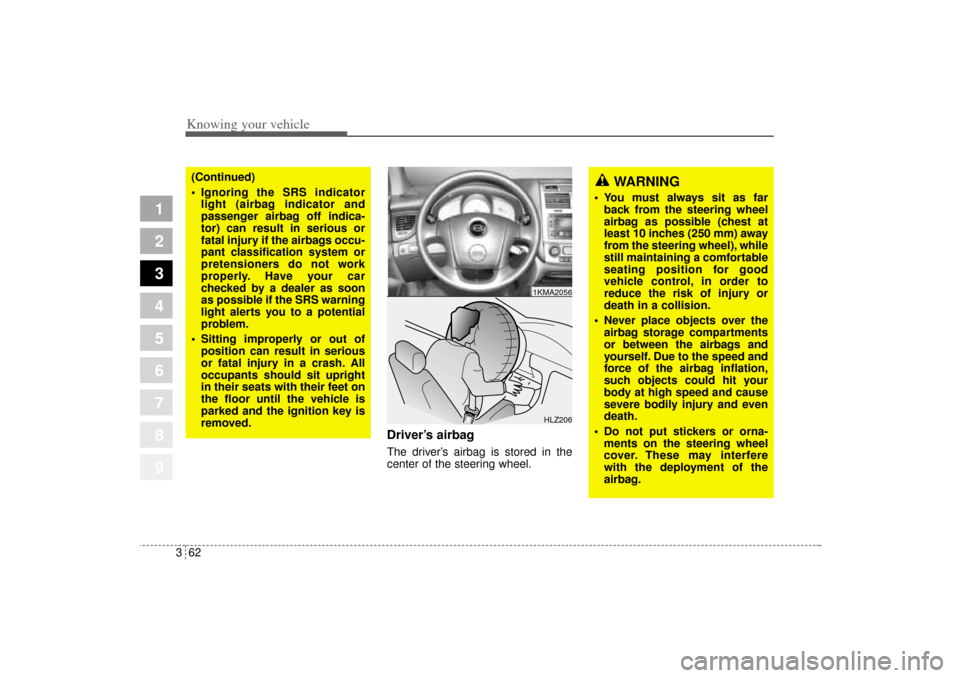
Knowing your vehicle62 3
1
2
3
4
5
6
7
8
9
Driver’s airbagThe driver’s airbag is stored in the
center of the steering wheel.
(Continued)
Ignoring the SRS indicator
light (airbag indicator and
passenger airbag off indica-
tor) can result in serious or
fatal injury if the airbags occu-
pant classification system or
pretensioners do not work
properly. Have your car
checked by a dealer as soon
as possible if the SRS warning
light alerts you to a potential
problem.
Sitting improperly or out of
position can result in serious
or fatal injury in a crash. All
occupants should sit upright
in their seats with their feet on
the floor until the vehicle is
parked and the ignition key is
removed.
WARNING
You must always sit as far
back from the steering wheel
airbag as possible (chest at
least 10 inches (250 mm) away
from the steering wheel), while
still maintaining a comfortable
seating position for good
vehicle control, in order to
reduce the risk of injury or
death in a collision.
Never place objects over the
airbag storage compartments
or between the airbags and
yourself. Due to the speed and
force of the airbag inflation,
such objects could hit your
body at high speed and cause
severe bodily injury and even
death.
Do not put stickers or orna-
ments on the steering wheel
cover. These may interfere
with the deployment of the
airbag.
HLZ2061KMA2056
KM CAN (ENG) 3 (~112).qxd 9/13/2004 4:50 PM Page 62
Page 74 of 354
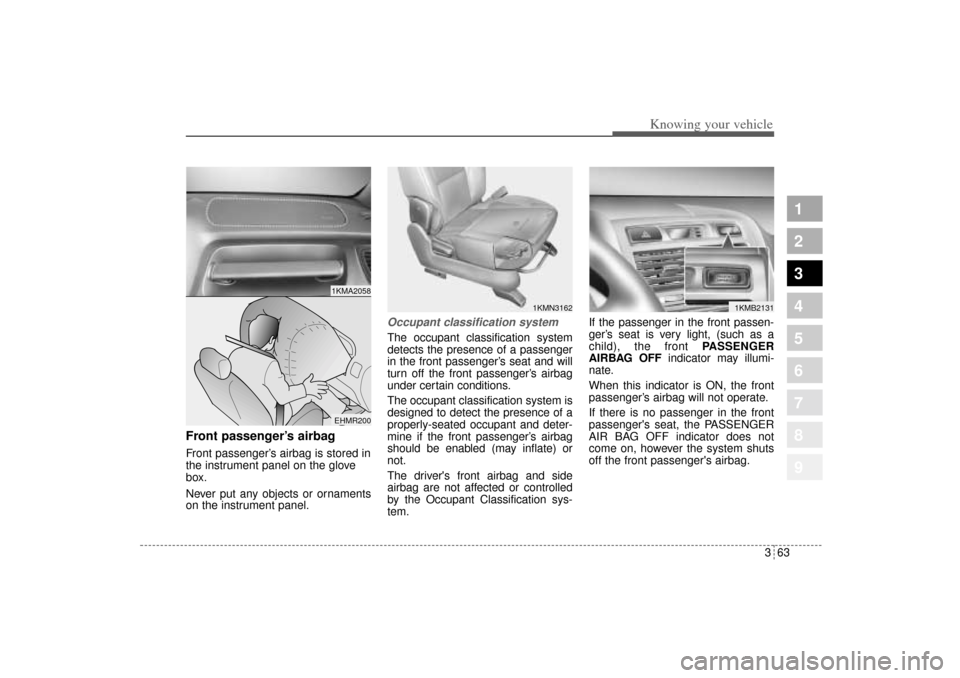
363
1
2
3
4
5
6
7
8
9
Knowing your vehicle
Front passenger’s airbagFront passenger’s airbag is stored in
the instrument panel on the glove
box.
Never put any objects or ornaments
on the instrument panel.
Occupant classification systemThe occupant classification system
detects the presence of a passenger
in the front passenger’s seat and will
turn off the front passenger’s airbag
under certain conditions.
The occupant classification system is
designed to detect the presence of a
properly-seated occupant and deter-
mine if the front passenger’s airbag
should be enabled (may inflate) or
not.
The driver's front airbag and side
airbag are not affected or controlled
by the Occupant Classification sys-
tem.If the passenger in the front passen-
ger’s seat is very light, (such as a
child), the front PASSENGER
AIRBAG OFFindicator may illumi-
nate.
When this indicator is ON, the front
passenger’s airbag will not operate.
If there is no passenger in the front
passenger's seat, the PASSENGER
AIR BAG OFF indicator does not
come on, however the system shuts
off the front passenger's airbag.
1KMB2131
1KMN3162
1KMA2058EHMR200
KM CAN (ENG) 3 (~112).qxd 9/13/2004 4:50 PM Page 63
Page 75 of 354
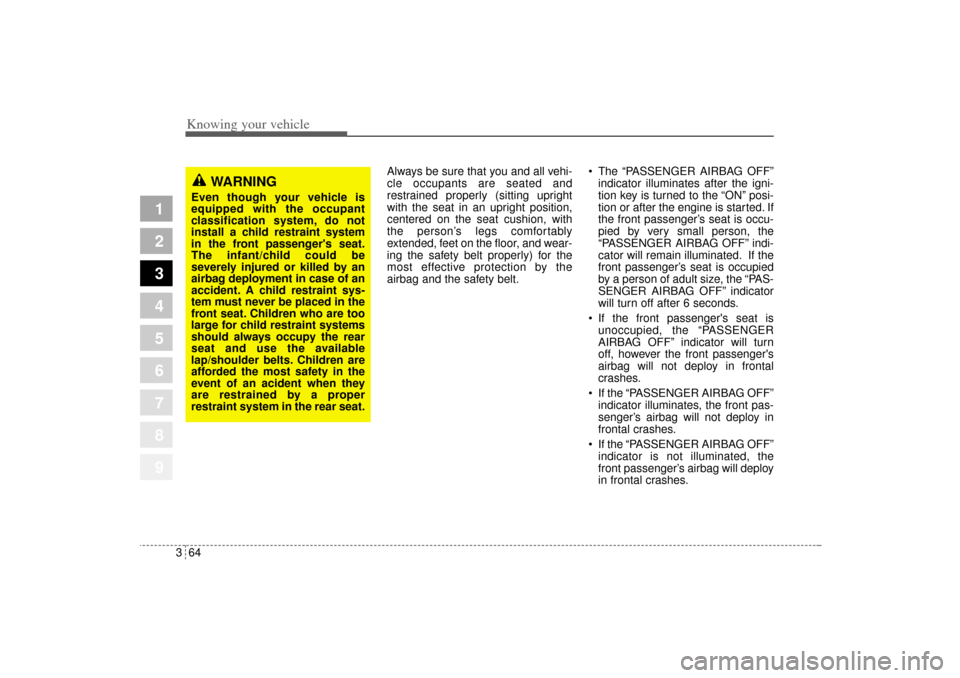
Knowing your vehicle64 3
1
2
3
4
5
6
7
8
9
Always be sure that you and all vehi-
cle occupants are seated and
restrained properly (sitting upright
with the seat in an upright position,
centered on the seat cushion, with
the person’s legs comfortably
extended, feet on the floor, and wear-
ing the safety belt properly) for the
most effective protection by the
airbag and the safety belt. The “PASSENGER AIRBAG OFF”
indicator illuminates after the igni-
tion key is turned to the “ON” posi-
tion or after the engine is started. If
the front passenger’s seat is occu-
pied by very small person, the
“PASSENGER AIRBAG OFF” indi-
cator will remain illuminated. If the
front passenger’s seat is occupied
by a person of adult size, the “PAS-
SENGER AIRBAG OFF” indicator
will turn off after 6 seconds.
If the front passenger's seat is
unoccupied, the “PASSENGER
AIRBAG OFF” indicator will turn
off, however the front passenger's
airbag will not deploy in frontal
crashes.
If the “PASSENGER AIRBAG OFF”
indicator illuminates, the front pas-
senger’s airbag will not deploy in
frontal crashes.
If the “PASSENGER AIRBAG OFF”
indicator is not illuminated, the
front passenger’s airbag will deploy
in frontal crashes.
WARNING
Even though your vehicle is
equipped with the occupant
classification system, do not
install a child restraint system
in the front passenger's seat.
The infant/child could be
severely injured or killed by an
airbag deployment in case of an
accident. A child restraint sys-
tem must never be placed in the
front seat. Children who are too
large for child restraint systems
should always occupy the rear
seat and use the available
lap/shoulder belts. Children are
afforded the most safety in the
event of an acident when they
are restrained by a proper
restraint system in the rear seat.
KM CAN (ENG) 3 (~112).qxd 9/13/2004 4:50 PM Page 64
Page 76 of 354
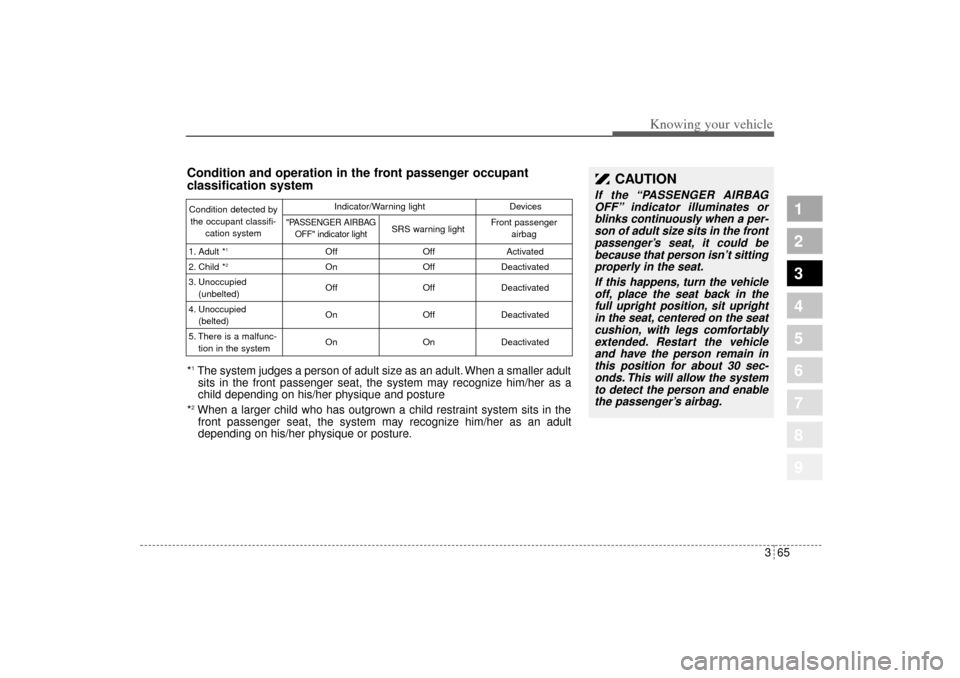
365
1
2
3
4
5
6
7
8
9
Knowing your vehicle
CAUTION
If the “PASSENGER AIRBAG
OFF” indicator illuminates or
blinks continuously when a per-
son of adult size sits in the front
passenger’s seat, it could be
because that person isn’t sitting
properly in the seat.
If this happens, turn the vehicle
off, place the seat back in the
full upright position, sit upright
in the seat, centered on the seat
cushion, with legs comfortably
extended. Restart the vehicle
and have the person remain in
this position for about 30 sec-
onds. This will allow the system
to detect the person and enable
the passenger’s airbag.
Condition and operation in the front passenger occupant
classification systemCondition detected by
the occupant classifi-
cation system
1. Adult *
1
2. Child *
2
3. Unoccupied
(unbelted)
4. Unoccupied
(belted)
5. There is a malfunc-
tion in the system Off
On
Off
On
OnOff
Off
Off
Off
OnActivated
Deactivated
Deactivated
Deactivated
Deactivated
"PASSENGER AIRBAG
OFF" indicator light
SRS warning lightFront passenger
airbag Indicator/Warning light Devices
*1The system judges a person of adult size as an adult. When a smaller adult
sits in the front passenger seat, the system may recognize him/her as a
child depending on his/her physique and posture
*2When a larger child who has outgrown a child restraint system sits in the
front passenger seat, the system may recognize him/her as an adult
depending on his/her physique or posture.
KM CAN (ENG) 3 (~112).qxd 9/13/2004 4:50 PM Page 65
Page 77 of 354
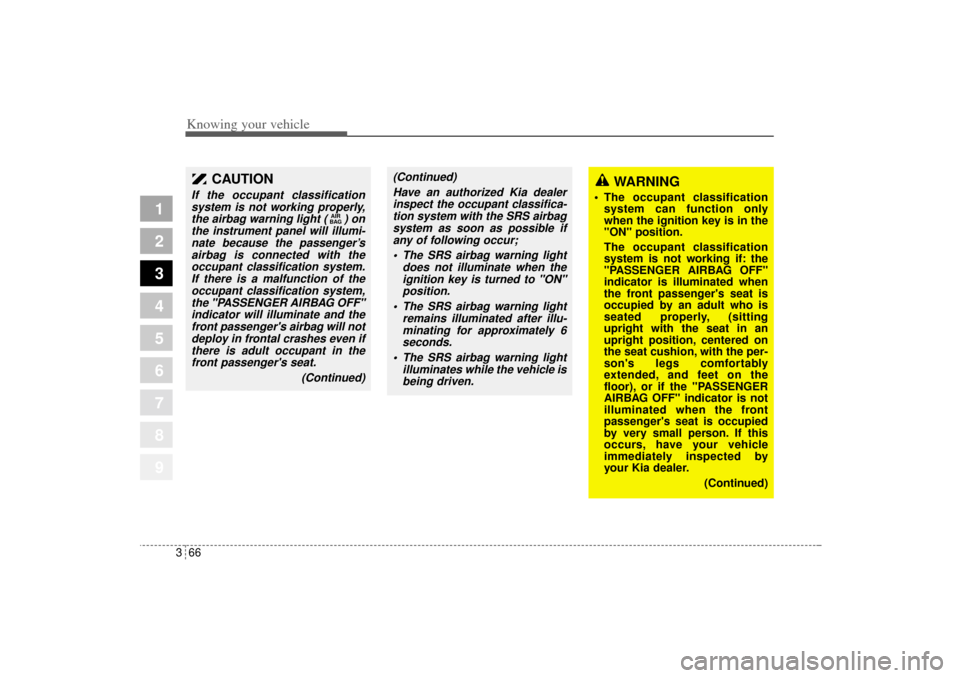
Knowing your vehicle66 3
1
2
3
4
5
6
7
8
9
CAUTION
If the occupant classification
system is not working properly,
the airbag warning light ( ) on
the instrument panel will illumi-
nate because the passenger’s
airbag is connected with the
occupant classification system.
If there is a malfunction of the
occupant classification system,
the "PASSENGER AIRBAG OFF"
indicator will illuminate and the
front passenger's airbag will not
deploy in frontal crashes even if
there is adult occupant in the
front passenger's seat.
(Continued)
AIR
BAG
(Continued)
Have an authorized Kia dealer
inspect the occupant classifica-
tion system with the SRS airbag
system as soon as possible if
any of following occur;
The SRS airbag warning light
does not illuminate when the
ignition key is turned to "ON"
position.
The SRS airbag warning light
remains illuminated after illu-
minating for approximately 6
seconds.
The SRS airbag warning light
illuminates while the vehicle is
being driven.
WARNING
The occupant classification
system can function only
when the ignition key is in the
"ON" position.
The occupant classification
system is not working if: the
"PASSENGER AIRBAG OFF"
indicator is illuminated when
the front passenger's seat is
occupied by an adult who is
seated properly, (sitting
upright with the seat in an
upright position, centered on
the seat cushion, with the per-
son's legs comfortably
extended, and feet on the
floor), or if the "PASSENGER
AIRBAG OFF" indicator is not
illuminated when the front
passenger's seat is occupied
by very small person. If this
occurs, have your vehicle
immediately inspected by
your Kia dealer.
(Continued)
KM CAN (ENG) 3 (~112).qxd 9/13/2004 4:50 PM Page 66
Page 78 of 354
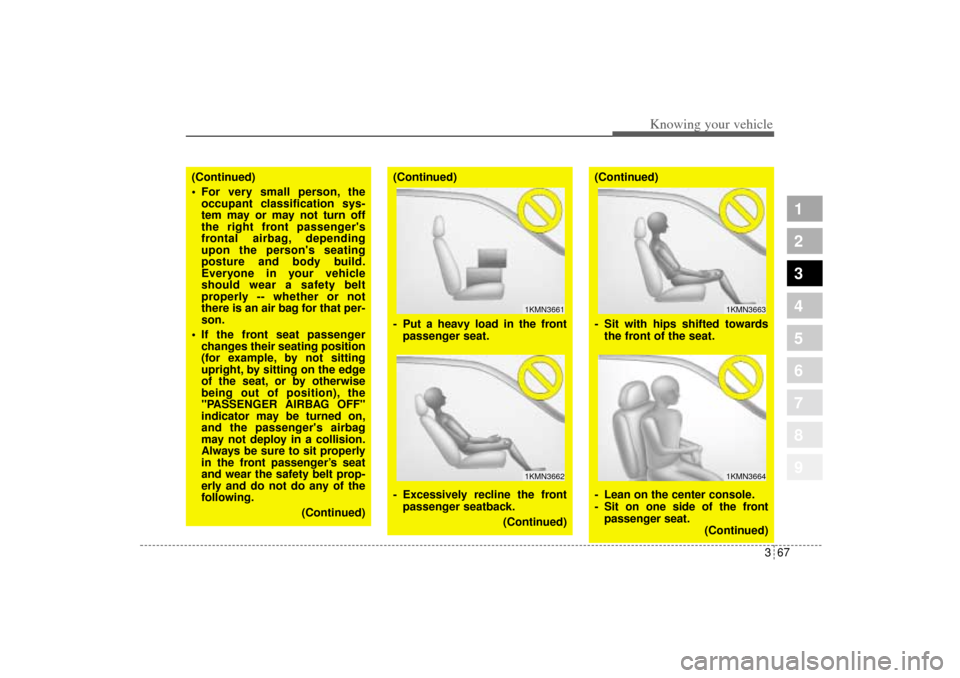
367
1
2
3
4
5
6
7
8
9
Knowing your vehicle
(Continued)
For very small person, the
occupant classification sys-
tem may or may not turn off
the right front passenger's
frontal airbag, depending
upon the person's seating
posture and body build.
Everyone in your vehicle
should wear a safety belt
properly -- whether or not
there is an air bag for that per-
son.
If the front seat passenger
changes their seating position
(for example, by not sitting
upright, by sitting on the edge
of the seat, or by otherwise
being out of position), the
"PASSENGER AIRBAG OFF"
indicator may be turned on,
and the passenger's airbag
may not deploy in a collision.
Always be sure to sit properly
in the front passenger’s seat
and wear the safety belt prop-
erly and do not do any of the
following.
(Continued)
(Continued)
- Put a heavy load in the front
passenger seat.
- Excessively recline the front
passenger seatback.
(Continued)
1KMN36611KMN3662
(Continued)
- Sit with hips shifted towards
the front of the seat.
- Lean on the center console.
- Sit on one side of the front
passenger seat.
(Continued)
1KMN36631KMN3664
KM CAN (ENG) 3 (~112).qxd 9/13/2004 4:50 PM Page 67
Page 79 of 354
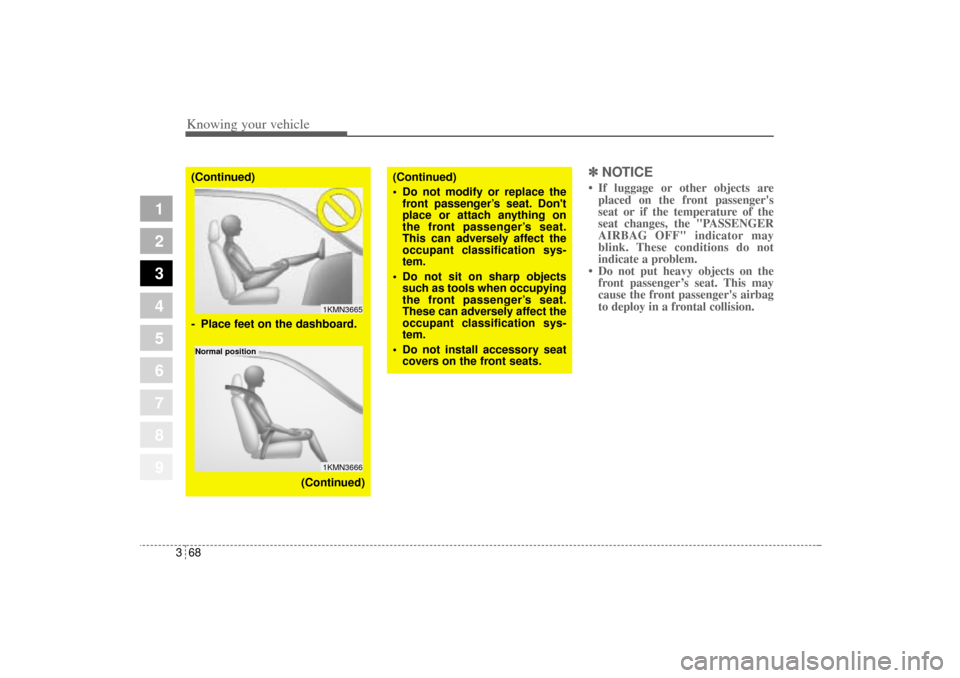
Knowing your vehicle68 3
1
2
3
4
5
6
7
8
9
✽ ✽
NOTICE• If luggage or other objects are
placed on the front passenger's
seat or if the temperature of the
seat changes, the "PASSENGER
AIRBAG OFF" indicator may
blink. These conditions do not
indicate a problem.
• Do not put heavy objects on the
front passenger’s seat. This may
cause the front passenger's airbag
to deploy in a frontal collision.
(Continued)
Do not modify or replace the
front passenger’s seat. Don't
place or attach anything on
the front passenger’s seat.
This can adversely affect the
occupant classification sys-
tem.
Do not sit on sharp objects
such as tools when occupying
the front passenger’s seat.
These can adversely affect the
occupant classification sys-
tem.
Do not install accessory seat
covers on the front seats.
(Continued)
- Place feet on the dashboard.
(Continued)
1KMN36651KMN3666
Normal position
KM CAN (ENG) 3 (~112).qxd 9/13/2004 4:50 PM Page 68
Page 80 of 354
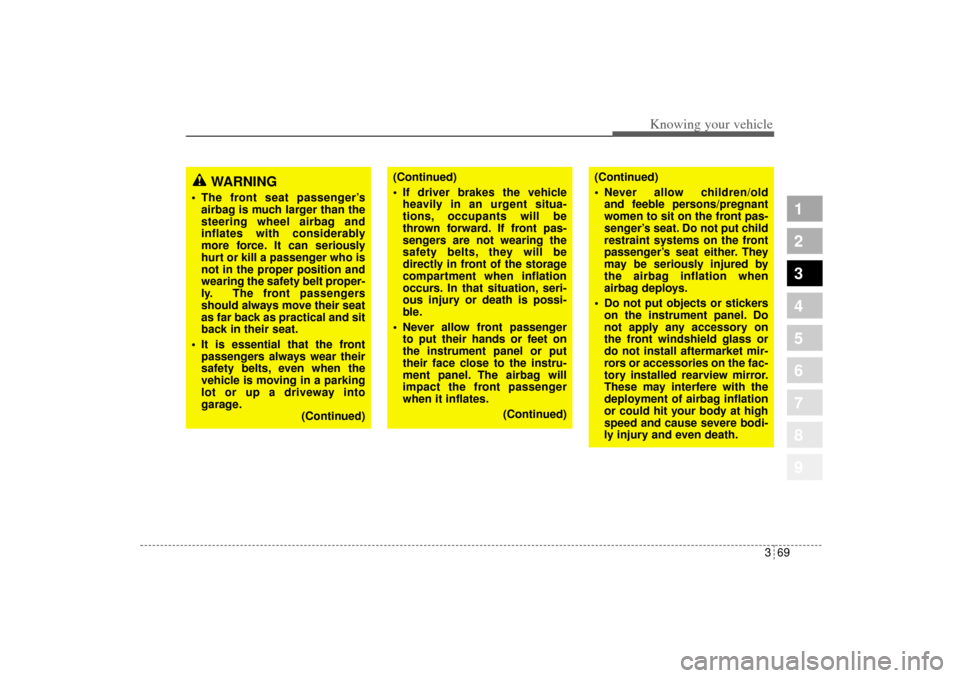
369
1
2
3
4
5
6
7
8
9
Knowing your vehicle
(Continued)
If driver brakes the vehicle
heavily in an urgent situa-
tions, occupants will be
thrown forward. If front pas-
sengers are not wearing the
safety belts, they will be
directly in front of the storage
compartment when inflation
occurs. In that situation, seri-
ous injury or death is possi-
ble.
Never allow front passenger
to put their hands or feet on
the instrument panel or put
their face close to the instru-
ment panel. The airbag will
impact the front passenger
when it inflates.
(Continued)
(Continued)
Never allow children/old
and feeble persons/pregnant
women to sit on the front pas-
senger’s seat. Do not put child
restraint systems on the front
passenger’s seat either. They
may be seriously injured by
the airbag inflation when
airbag deploys.
Do not put objects or stickers
on the instrument panel. Do
not apply any accessory on
the front windshield glass or
do not install aftermarket mir-
rors or accessories on the fac-
tory installed rearview mirror.
These may interfere with the
deployment of airbag inflation
or could hit your body at high
speed and cause severe bodi-
ly injury and even death.
WARNING
The front seat passenger’s
airbag is much larger than the
steering wheel airbag and
inflates with considerably
more force. It can seriously
hurt or kill a passenger who is
not in the proper position and
wearing the safety belt proper-
ly. The front passengers
should always move their seat
as far back as practical and sit
back in their seat.
It is essential that the front
passengers always wear their
safety belts, even when the
vehicle is moving in a parking
lot or up a driveway into
garage.
(Continued)
KM CAN (ENG) 3 (~112).qxd 9/13/2004 4:50 PM Page 69